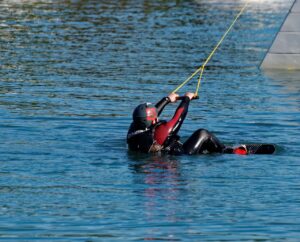Wakeboarding is a fantastic recreational activity and a very vigorous form of water sports. If you’re shopping for a wetsuit for wakeboarding, you’ll want one with lots of mobility. Wetsuits come in many thicknesses and are usually laid out in mm units.
The thinner the neoprene, the more flexible it is but also the less heat retention it provides. A wetsuit that can provide warmth while maintaining flexibility is your best bet. For more active water sports like wakeboarding, a 60 percent super-stretch neoprene 3/2 mm thick wetsuit is ideal.
What’s The Difference Between Standard & Super Stretch Neoprene
On the other hand, high-performance waterproof neoprene is ideal for leisure time in the water but isn’t as flexible. Super stretch neoprene gives far greater mobility and may be created in a variety of formulations.
Neoprene wetsuits with 60 percent or 100 percent super-stretch are preferred by surfers and wakeboarders since they provide the greatest comfort and flexibility.
How Thick Should My Wetsuit Be For Cold Water Conditions
When wakeboarding in colder temperatures, you may need to wear a thicker wetsuit to keep you warm. A 5/3 mm 60% super-stretch neoprene wetsuit is an excellent compromise between warmth and flexibility.
You can choose a wetsuit with sealed, glued, and Blindstitched seams to keep water from infiltrating your wetsuit when wakeboarding. You might want to try wearing a poly fleece undershirt if you’re feeling chilly.
This is an excellent technique to increase the thermal insulation of a wetsuit while minimizing flexibility.
How To Choose A Kids Wetsuit
You should get a wetsuit that fits comfortably. It shouldn’t constrict breathing or mobility, but it should lightly cling to the body. There are many different types of wetsuits on the market for youngsters, so you should be able to discover one that works for you and your budget.
If your children enjoy spending time in the water, you’ll have to replace their suit every year until they’re adults. You can’t purchase a suit that fits for several years of development like other apparel. A bigger wetsuit would be too baggy and not fit properly.
This implies that it would not keep them warm. You can’t expect children to don wetsuits that are too tight, as they’ll be uncomfortable and less heat efficient.
How To Fix Rips In Wetsuits
Neoprene repair kits are available if you have small tears or rips in your wetsuit. They’re simple to use, and the rip may nearly be “glued” together. However, because your wetsuit will be more vulnerable to further damage, you must be cautious.
You’ll want to preserve your wetsuit for as long as possible, especially if it has a significant rip or hole in it.
How To Prevent Your Wetsuit From Rubbing Around The Neck
If you spend a lot of time wakeboarding, you might get rubbing in certain places, such as the neck collar and arms. This can result in an uncomfortable red friction burn on your skin.
If you don’t have a rash vest, you may use your wetsuit to help prevent this. This tight-fitting garment does not limit movement and serves as an added protection for your skin against rubbing.
Which Manufacturer Should I Purchase A Wakeboarding Wetsuit From
You can be confident that the wetsuit you buy will have a good fit and is made of high-quality neoprene if you choose the best brand name. If you’re using a lot of wakeboard, this is crucial because better quality suits retain heat longer and provide greater mobility.
If you buy a low-quality wetsuit, you’ll save money to begin with, but in the end, it may cost you much more. Low-cost suits are considerably more prone to UV light and water chemicals causing damage. They also rip more readily, leaving you to replace them every season if they don’t last too long.
Are Shorty Wetsuit Suitable For Wakeboarding
Yes. Shorty wetsuits have t-shirt style short sleeve arms and short like legs that end just below the knee. Because of their flexibility in the limb parts, these wetsuits are ideal for active sports such as wakeboarding.
The Thinsulate wetsuits are not heat-retaining, so they’re more suited for warmer weather and waters. Full-body wetsuits are more appropriate for cooler water situations and individuals who spend a lot of time in the water.
What Is A Semi-Dry Wakeboarding Wetsuit
In very cold water, semi-dry suits are employed. They’re full-body coverings with reinforced seams that provide additional warmth and protection. They also include inner seals around the neck, wrists, and ankles to prevent flushing (cold water entering the suit via forcing warm water out).
These top-of-the-line suits might be costly, but if you plan on wakeboarding in extremely chilly weather, they can assist keep you warm and toasty.
What Are The Different Types Of Neoprene For Wetsuits
Wetsuits are made of three different types of neoprene. The following are the most common:
Single Lined Neoprene
A single layer of neoprene has a nylon interior. The inside of the neoprene is lined with nylon. It makes it easier to put on and take off the wetsuit, which is a big plus. It also keeps you warmer by providing more thermal insulation.
Double-Lined Neoprene
The inside and outside of this neoprene are both marked with a line. This raises the wearer’s core temperature and adds to the suit’s longevity. The extra exterior layer allows water to run off, lowering heat loss. Double-lined neoprene is used in most water sports wetsuits for enhanced strength and durability.
Titanium Lined Neoprene
The thermal properties of neoprene are improved by adding titanium neoprene to the main body panels of neoprene suits. The majority of the top-of-the-line wetsuits on the market include titanium liners in order to improve heat retention.
